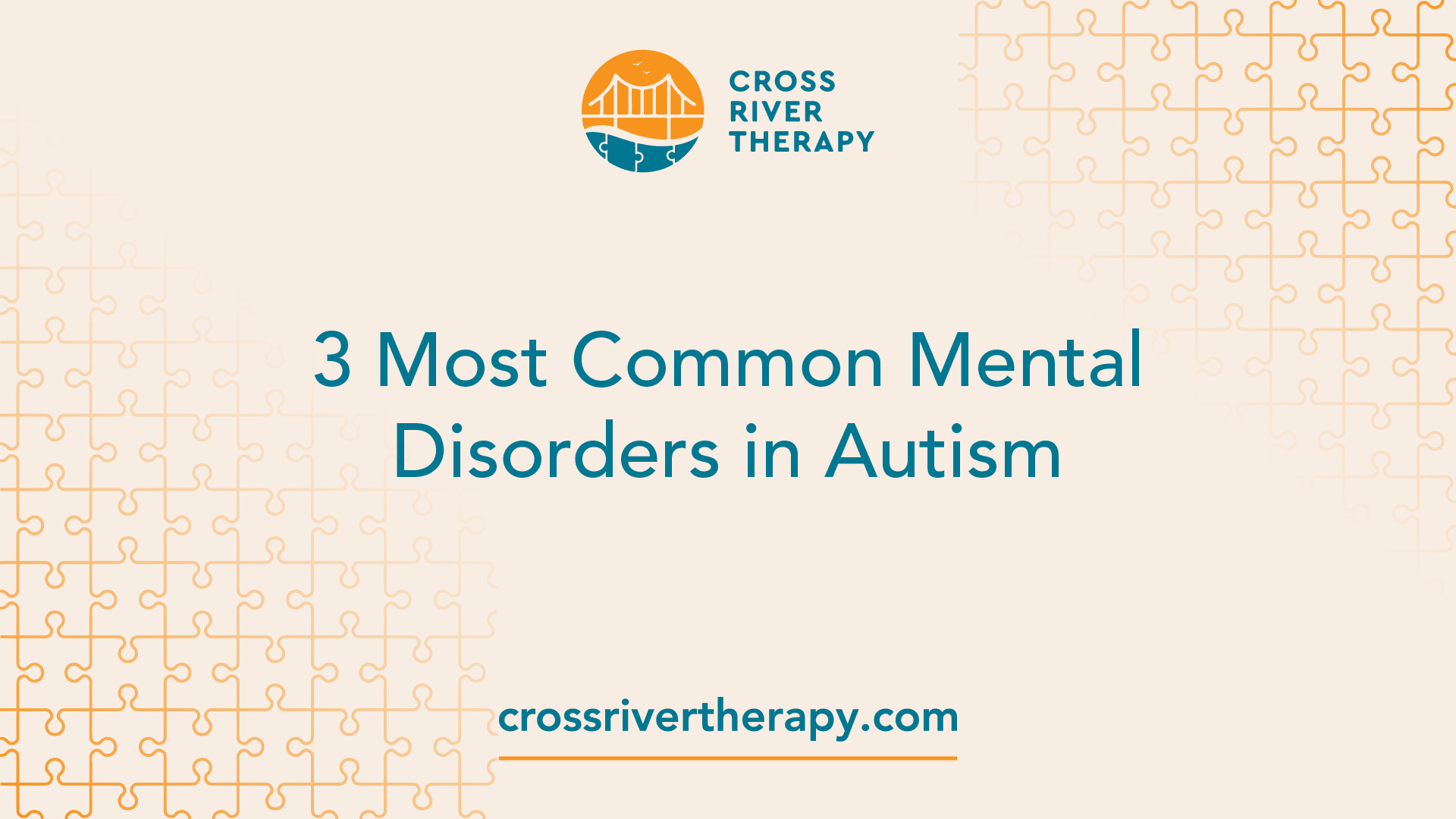3 Most Common Mental Disorders in Autism
Explore the most common mental disorders in autism and learn tactics to manage them effectively.
Understanding Autism and Mental Disorders
Autism Spectrum Disorder (ASD) and mental disorders often go hand in hand. Understanding this co-occurrence is crucial in promoting the well-being of those diagnosed with ASD. The focus of this article will be to define ASD and to highlight the most common mental disorders associated with it.
Defining Autism Spectrum Disorder
Autism Spectrum Disorder (ASD) is a developmental disorder characterized by challenges with social skills, repetitive behaviors, speech, and nonverbal communication. It's called a "spectrum" as it encompasses a wide range of skills, symptoms, and disability levels. Each individual with ASD is unique and may present with different challenges and strengths.

Recognizing Common Mental Disorders
The complexity of ASD is further compounded by the prevalence of co-occurring mental disorders. Anxiety disorders, depression, attention-deficit/hyperactivity disorder (ADHD), and obsessive-compulsive disorder (OCD) are among the common mental disorders that can occur in individuals with ASD.
Data Courtesy: NICHD
Symptoms of these mental health issues can often overlap with symptoms of autism, making it challenging to diagnose and treat additional mental health conditions in people with autism [2].
Autistic individuals also commonly show additional psychiatric conditions such as Tourettes and eating disorders, alongside ASD.
The presence of these co-occurring mental health disorders can complicate the overall quality of life for individuals with autism, requiring tailored treatment approaches to address both the core features of autism and the additional mental health challenges. Understanding these common mental disorders in autism is a crucial step in providing comprehensive care and support to those affected.
Anxiety Disorders and Autism
Among the most common mental disorders in autism, anxiety disorders stand out due to their high prevalence. The co-occurrence of these conditions can pose unique challenges for individuals on the autism spectrum and those who support them.
Anxiety Disorders in Autistic Individuals
Anxiety disorders are one of the most common mental health issues in individuals with autism spectrum disorder, affecting up to 84% of children with autism. These disorders can manifest in various forms, including generalized anxiety disorder, social anxiety disorder, and specific phobias.
It's important to note that symptoms of these mental health issues can often overlap with symptoms of autism, making it challenging to diagnose and treat additional mental health conditions in individuals with autism [2]. For example, social anxiety might be misinterpreted as a symptom of autism itself rather than a separate, co-occurring condition.
Managing Anxiety in Autism
The presence of anxiety disorders can complicate the overall quality of life for individuals with autism. As such, it is crucial to seek effective management strategies. These may require tailored treatment approaches that address both the core features of autism and the additional mental health challenges [2].
Treatment options for managing anxiety in autistic individuals can include cognitive-behavioral therapy (CBT), which can be adapted to meet the unique needs of this population. Other beneficial approaches may include mindfulness techniques, medication, and supportive therapies such as occupational or speech therapy.
It's essential to work closely with healthcare professionals who have expertise in both autism and anxiety disorders to ensure that the treatment plan is effective and considerate of the individual's unique needs and circumstances.
In conclusion, while anxiety disorders are common in individuals with autism, they are not insurmountable. With the right support and treatment strategies, individuals with autism can manage these symptoms and improve their overall quality of life.
Co-Occurrence of ADHD and Autism
One of the most common mental disorders in autism is attention-deficit/hyperactivity disorder (ADHD). Understanding its prevalence and how it is addressed in individuals with autism is crucial to providing effective care and support.
ADHD Prevalence in Autism
ADHD is common among children with autism. Estimates suggest that up to 60% of children with autism also have ADHD. This high prevalence rate underscores the interconnected nature of these two disorders and the importance of recognizing ADHD symptoms in individuals with autism.
ADHD in individuals with autism can manifest as an inability to focus, hyperactivity, and impulsive behavior. These symptoms can be challenging to manage, especially when coupled with the communication and social interaction difficulties characteristic of autism. Consequently, the co-occurrence of ADHD and autism necessitates a comprehensive approach to care that addresses both disorders.
Addressing ADHD in Autistic People
Managing ADHD in individuals with autism can be complex due to the unique needs and characteristics of these individuals. Therapeutic interventions often involve a combination of medication, behavioral therapy, and educational support. The aim is to help individuals manage their symptoms, improve their focus and attention, and enhance their overall functioning.
Medication, such as stimulants, non-stimulants, and certain antidepressants, can be effective in managing ADHD symptoms. However, these medications should be used under the supervision of a healthcare professional due to potential side effects and interactions.
Behavioral therapy is another cornerstone of ADHD management. Techniques such as cognitive-behavioral therapy can help individuals develop coping strategies, improve their social skills, and enhance their problem-solving abilities. In addition to individual therapy, family therapy can also be beneficial in educating family members about ADHD and providing them with strategies to support their loved one.
Educational support is also crucial in managing ADHD in individuals with autism. Schools can provide accommodations and modifications to help students with ADHD succeed in the academic setting. This can include things like additional time on tests, a quiet space for work, and assistance with organization and planning.
Overall, addressing ADHD in individuals with autism requires a multidisciplinary approach that is tailored to the individual's unique needs and circumstances. With the right support and resources, individuals with autism and ADHD can lead fulfilling and productive lives.
Depression in Autism Spectrum Disorder
Depression is one of the most common mental disorders that can co-occur with autism. Understanding its manifestation and possible therapeutic interventions is crucial for supporting individuals with autism.

Identifying Depression in Autism
Among individuals with Autism Spectrum Disorder (ASD), approximately 30-50% experience symptoms that meet the diagnostic criteria for depression Raising Children Network. These rates are substantially higher compared to the general population, indicating that psychiatric difficulties are 15 times more common in individuals with autism NCBI.
Depression can manifest differently in autistic individuals than in the general population. They may not express typical symptoms like sadness or loss of interest. Instead, indicators may include increased repetitive behaviors, aggression, self-injury, or a notable decrease in skills or interests. Identifying depression in individuals with autism requires a nuanced understanding of both conditions and a careful observation of behavioral changes.
Therapeutic Interventions for Depression
Given the high prevalence of depression among those with autism, therapeutic interventions are critical. The treatment plan should be tailored to the individual's needs, taking into account their unique experiences and manifestations of depression.
Cognitive-behavioral therapy (CBT) is a common approach to treat depression, including among those with autism. This form of therapy helps individuals understand and manage their thought processes, which can influence their behaviors and emotions. For individuals with autism, CBT may be adapted to accommodate their unique communication and learning styles.
In some cases, medication may be considered. Selective serotonin reuptake inhibitors (SSRIs) are often used to treat depression, but their effectiveness in individuals with autism is still under research. It's crucial to consider potential side effects and to monitor the individual's response closely.
In addition to these interventions, providing a supportive environment can help manage depression. This may involve opportunities for social interaction, routines that provide predictability, and accommodations to reduce sensory overload.
In conclusion, depression is a significant concern in individuals with autism. Recognizing its symptoms and providing appropriate therapeutic interventions can greatly improve their quality of life. As every individual with autism is unique, so too are their experiences with depression. Tailored strategies are essential to effectively address this common mental disorder in autism.
Obsessive-Compulsive Disorder and Autism
One of the common mental disorders that can occur in individuals with autism spectrum disorder (ASD) is Obsessive-Compulsive Disorder (OCD) Mayo Clinic. Understanding the symptoms and effective treatment strategies can aid in managing this co-occurring condition.
OCD Symptoms in Autistic Individuals
Autistic individuals who also have OCD might exhibit repetitive behaviors and rigid routines that go beyond those typically associated with ASD. They might have intrusive thoughts or worries that can involve various themes, which they often try to alleviate by performing specific rituals or behaviors.
In autism, these behaviors can be similar to the repetitive behaviors seen as part of the autism spectrum disorder itself. This overlap of symptoms can often make it challenging to diagnose and treat OCD in individuals with autism NICHD.
Treatment Strategies for OCD
When treating OCD in individuals with autism, a tailored approach is often required, taking into account both the core features of autism and the additional mental health challenges. Cognitive-behavioral therapy (CBT) is commonly used to treat OCD, and it can be adapted to suit the needs of individuals with autism.
CBT for OCD typically involves exposure and response prevention (ERP), a technique where individuals are gradually exposed to their fears or obsessions and learn to resist the urge to perform the compulsive behaviors. In addition to CBT, medication such as selective serotonin reuptake inhibitors (SSRIs) may also be used as part of the treatment plan.
However, just as every individual with autism is unique, the effectiveness of these treatments can vary from person to person. It's important for healthcare providers to work closely with the individual and their families to develop a personalized treatment plan that takes into account the individual's specific symptoms, needs, and preferences.
In conclusion, while OCD is a common co-occurring condition in individuals with autism, recognizing the symptoms and adopting a tailored treatment approach can significantly improve the quality of life of these individuals NICHD.
Impact of Co-Occurring Mental Disorders
The presence of co-occurring mental health disorders in individuals with autism spectrum disorder (ASD) can significantly impact their overall quality of life and can necessitate tailored treatment approaches. These disorders, which include ADHD, anxiety disorder, depression, and obsessive-compulsive disorder among others, often present additional challenges and complications for both individuals and their support systems.
Quality of Life Concerns
The reality of these co-occurring conditions is concerning, as they are substantially more common in the population with autism (15 times more common) compared to the general population [3]. Furthermore, previous studies have found that 70% of ten- to 14-year-olds with ASD meet criteria for at least one additional disorder, with 41% having two or more problems in addition to ASD. The most common disorders to co-occur with ASD are social anxiety, hyperactivity, and oppositional defiant disorder.
The presence of these additional mental health disorders can further complicate the everyday life of individuals with autism. They can exacerbate difficulties with social interactions, academic performance, and daily living skills, among others. Furthermore, these disorders can also contribute to increased isolation, reduced independence, and lower overall life satisfaction.
Tailored Approaches for Treatment
Given the complex nature of ASD and the high prevalence of co-occurring mental health disorders, a tailored approach to treatment is essential. This approach should not only address the core features of autism but also the additional mental health challenges that these individuals face [2].
Addressing mental health concerns and providing appropriate treatment for co-occurring conditions is crucial in enhancing the overall well-being and quality of life for individuals with autism. This may involve a combination of therapeutic interventions, including behavioral therapy, cognitive-behavioral therapy, medication, and supportive services like counseling and educational support [2].
By understanding the unique needs and challenges of each individual, healthcare providers, educators, and caregivers can develop a comprehensive care plan that effectively addresses the 'most common mental disorders in autism'. This personalized approach can significantly improve the quality of life for those living with autism, helping them navigate their world with greater confidence and resilience.
References
[2]: https://www.nichd.nih.gov/health/topics/autism/conditioninfo/treatments
[3]: https://www.ncbi.nlm.nih.gov/pmc/articles/PMC8854265/
[4]: https://raisingchildren.net.au/autism/learning-about-autism/about-autism/conditions-that-occur-with-asd



